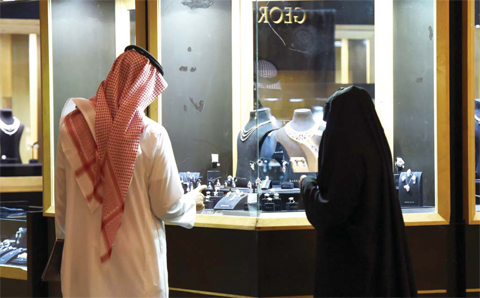 RIYADH: A Saudi couple looks at jewelry during the Riyadh international Jewelry exhibition in the Saudi capital Riyadh. — AFP
RIYADH: A Saudi couple looks at jewelry during the Riyadh international Jewelry exhibition in the Saudi capital Riyadh. — AFPRIYADH: Saudi Arabia may be facing its biggest economic challenge in years but there's little talk of falling oil revenues or austerity at Riyadh's glittering annual Jewelry Salon. Women in traditional black abaya robes stroll through the showrooms at a luxury Riyadh hotel, as muscle-bound security men patrol. Hanging unobtrusively in a small glass display case is a chunky 30-carat emerald cut set of diamond earrings offered by London's Moussaieff, one of more than 20 vendors at this year's show, which began on Monday.
The price: $3.5 million. "The rich are always rich," says Leslie Kegg, a Moussaieff salesman. "If you have so much money you're never affected. When someone else loses money, someone else makes money." The biggest economy in the Arab world, Saudi Arabia has for decades enjoyed a windfall from its massive oil industry. But the global collapse in crude prices over the last two years-from more than $100 a barrel in early 2014 to around $40 this month-has put pressure on Riyadh to cut spending and to intensify its efforts to find economic alternatives.
Riyadh posted a record budget deficit in 2015. With another $87 billion shortfall projected for this year, the government took the unprecedented step of raising retail fuel prices by up to 80 percent in December and cutting subsidies for electricity, water and other services. It has also delayed some major projects and mooted privatizations and the imposition of taxes. On Monday the kingdom is to announce its "vision" for future social and economic development, including a "National Transformation Program" aimed at diversifying the economy away from oil, which still accounts for more than 70 percent of state revenues.
None of that was of much concern to Nouf Albaiz as she and two other young women browsed the layered necklaces, chunky rings and diamond-encrusted watches on display. Albaiz professed a relatively modest jewellery budget of 5,000 riyals ($1,300) for any purchase she might make, and said the total amount that she and her companions spend annually on jewelry "depends on the weddings" they have to attend.
'The dancing diamond'
Marwan Meneimneh, Saudi marketing manager of Qatari group Ali bin Ali, said the impact of the economic situation has been minimal. "We're still doing fine," he said, among stands displaying international brands distributed by the group. "For us it's not about sales. It's about being present and recruiting more clients," said Meneimneh, whose firm is in its fourth year at the show. "There's ups and downs," and for this year he and his colleagues are "crossing our fingers". Kegg, of Moussaieff, said he is "hopeful" for this year, as Saudis holding weddings in London provide a regular clientele. "We already have a very big customer base," he said.
The event, which runs until Thursday, was preceded by a Jewellery Salon in Jeddah which Kegg said also went well. "We can't complain," he said. Neither could Nouf Alghebewi, helping her aunt at their small and friendly corner kiosk in the back of the hall. "We have the dancing diamond," said the cheerful Alghebewi, holding up a shimmering little earring. "It's not that expensive. This is only 1,600" riyals ($415), she said. Alghebewi said her aunt's designer products are normally sold online, for the rich as well as the not-so-rich. She expressed confidence that the two-year-old business will "of course" prosper as spending on luxuries continues despite the kingdom's broader economic challenges.- AFP










